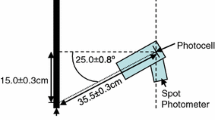Abstract
Purpose
The cathode-ray tube (CRT) screen has recently been replaced by liquid crystal display (LCD) screens as visual stimulators for pattern-reversal visually evoked potentials (p-VEPs). The aim of the study was to evaluate the usefulness of LCD screen to elicit p-VEPs.
Methods
The waveforms of the p-VEPs elicited by a LCD panel were compared with those elicited by a conventional CRT screen. The changes in the luminance of each screen were measured with a photodiode, and the mean luminance change was measured with a luminance meter. VEPs and electroretinograms (ERGs) were also recorded when the monitor was covered by a diffuser.
Results
The p-VEPs elicited by the LCD consisted of the N75 and P100 components of the conventional VEPs and had good reproducibility. The average latency of these components was significantly delayed by 9.8 ms for N75 and 10.2 ms for P100, and the N75-P100 amplitude was significantly larger than the conventional p-VEP elicited by the CRT screen. During the reversal phase, especially from black-to-white, the luminance of the LCD screen was transiently reduced, and it elicited a flash VEP and ERG. A reduction in the contrast of the checks minimized the transient change in the luminance, and the VEP waveform was more similar to that elicited by the CRT screen.
Conclusions
The results suggest that when an LCD monitor is used as an alternative visual stimulator to elicit p-VEPs, the delay in the luminance change and the flash effect needs to be taken into account.








Similar content being viewed by others
References
Odom JV, Bach M, Brigell M, Holder GE, McCulloch DL, Tormene AP, Vaegan (2010) ISCEV standard for clinical visual evoked potentials (2009 update). Doc Ophthalmol 120:111–119
den Boer W (2005) Liquid crystal properties. In: den Boer W (ed) Active matrix liquid crystal displays: fundamentals and applications. Newnes, Burlington, pp 7–10
ElzeT (2010) Achieving precise display timing in visual neuroscience experiments. J Neurosci Methods 191:171–179
Husain AM, Hayes S, Young M, Shah D (2009) Visual evoked potentials with CRT and LCD monitors. Neurology 72:162–164
Karanjia R, Brunet DG, ten Hove MW (2009) Optimization of visual evoked potential (VEP) recording systems. Can J Neurol Sci 36:89–92
Nagy BV, Gémesi S, Heller D, Magyar A, Farkas A, Abrahám G, Varsányi B (2011) Comparison of pattern VEP results acquired using CRT and TFT stimulators in the clinical practice. Doc Ophthalmol 7522:157–162
Matsumoto K, Matsumoto CS, Satofuka S, Seki K, Matsumoto H, Funada H, Shinoda K, Mizota A (2010) Pattern-reversal visual evoked potentials: usefulness of liquid crystal display monitors as a visual stimulator. Doc Ophthalmol 121(Suppl 1):54
Michelson A (1927) Studies in optics. University of Chicago Press, Chicago
Brainard DH, Pelli DG, Robson T (2002) Display characterization. In: Hornak J (ed) Encyclopedia of imaging science and technology. Wiley, Oxford, pp 172–188
Artamonov O (2007) Contemporary LCD monitor parameters: objective and subjective analysis. www.xbitlabs. com/articles/monitors/display/lcd-parameters.html (accessed 20 Sep 2011)
Acknowledgments
Support for this study was provided by Researches on Sensory and Communicative Disorders from the Ministry of Health, Labor, and Welfare, Japan.
Conflict of interest
H. Funada is an employee of Tomey Corp., Japan. None of other authors has any commercial relationship.
Author information
Authors and Affiliations
Corresponding author
Rights and permissions
About this article
Cite this article
Matsumoto, C.S., Shinoda, K., Matsumoto, H. et al. Liquid crystal display screens as stimulators for visually evoked potentials: flash effect due to delay in luminance changes. Doc Ophthalmol 127, 103–112 (2013). https://doi.org/10.1007/s10633-013-9387-9
Received:
Accepted:
Published:
Issue Date:
DOI: https://doi.org/10.1007/s10633-013-9387-9




